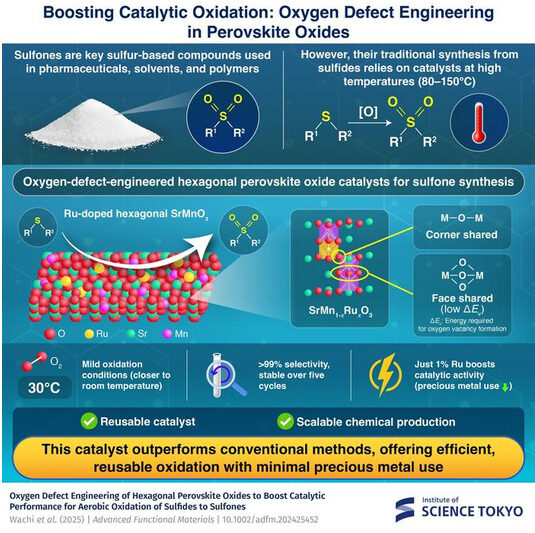
Revolutionizing Sulfones: Molecular Oxygen & Functional Catalysts

Researchers from Japan develop an efficient catalyst, SrMn₁₋ₓRuₓO₃ using oxygen defect engineering for sustainable synthesis of sulfone. Credit: Professor Keigo Kamata from Institute of Science Tokyo, Japan
Oxygen defect engineering enables efficient sulfone production using molecular oxygen at low temperature
Sulfones, a class of sulfur-containing compounds, are chemically derived from the selective oxidation of sulfides. While these compounds form the core of the pharmaceuticals, solvents and polymer industries, their chemical synthesis is often hindered by high reaction temperatures and extreme reaction conditions. Additionally, these also require costly additives and harsh solvents for production. Against this backdrop, a team of researchers from Japan introduced a new catalyst design, capable of overcoming the limitations of conventional synthesis, offering higher selectivity and a better yield for sulfones.
The research team, led by Professor Keigo Kamata from Institute of Science Tokyo, Japan, utilized advanced catalyst synthesis techniques to explore how variations in elemental composition and crystal structure contribute to catalytic performance for sulfide oxidation at a lower temperature. Their findings were published online in Advanced Functional Materials on April 03, 2025.
“Sulfide oxidation using molecular oxygen as the oxidant is one of the most challenging reactions in organic chemistry, and the development of new solid catalysts that can facilitate this type of reaction has gained considerable attention in recent years,” notes Kamata.
Addressing this demand, the researchers focused on perovskite oxide, a material widely used for catalysis. To enhance the reactivity of a specific metal-oxygen species (face-shared oxygen) in a hexagonal perovskite based on strontium (Sr), manganese (Mn) and oxygen (O) called SrMnO₃, they introduced ruthenium (Ru) atoms in place of some of the Mn atoms. This subtle modification created oxygen vacancies inside the crystal, which significantly improved the catalyst’s ability to transfer oxygen atoms—an essential step in sulfide oxidation.
The result was an efficient catalyst known as SrMn₁₋ₓRuₓO₃, which was capable of converting sulfides to sulfones with an unprecedented selectivity of 99% at a reaction temperature as low as 30°C. This was a dramatic shift from that of conventional systems, which typically require 80–150°C for the same reaction.
Conventional reaction systems rely on large amounts of precious metals for selectivity. While the researchers did utilize Ru, they achieved greater selectivity at just 1% Ru doping, which significantly cuts down the use of precious metals. Using mechanistic studies, the researchers further uncovered the mechanism behind the remarkable catalytic performance.
“The catalysis follows a Mars–van Krevelen mechanism, in which the oxygen atoms on the crystal surface transfer to the sulfides, leaving behind oxygen vacancies. These vacancies are then filled by molecular oxygen in the atmosphere, and the cycle continues,” explains Kamata.
Another striking advantage of the developed catalyst was its durability. The team confirmed that the catalyst could be reused at least five times without any significant loss of performance. Moreover, the system was applicable to a wide range of sulfide substrates, which included aromatic, aliphatic, making it highly versatile for industries.
While the present study focused only on sulfide oxidation, the implications of this work could extend to a wide range of oxidation reactions, transforming environmental cleanup and energy conversions. The team hopes that their findings will inspire new catalyst designs that offer greater sustainability and cost-efficiency. The research also underscores the synergistic effect of multiple elements in creating sustainable materials, paving the way for greener and smarter industrial chemistry.
***
About Institute of Science Tokyo (Science Tokyo)
Institute of Science Tokyo (Science Tokyo) was established on October 1, 2024, following the merger between Tokyo Medical and Dental University (TMDU) and Tokyo Institute of Technology (Tokyo Tech), with the mission of “Advancing science and human well-being to create value for and with society.”
Original Publication
Authors: Keiju Wachi, Masashi Makizawa, Takeshi Aihara, Shin Kiyohara, Yu Kumagai and Keigo Kamata.
Journal: Advanced Functional Materials
DOI: 10.1002/adfm.202425452
Method of Research: Experimental study
Subject of Research: Not applicable
Article Title: Oxygen Defect Engineering of Hexagonal Perovskite Oxides to Boost Catalytic Performance for Aerobic Oxidation of Sulfides to Sulfones
Article Publication Date: 3-Apr-2025
COI Statement: The authors declare no conflicts of interest.
Original Source: https://advanced.onlinelibrary.wiley.com/doi/full/10.1002/adfm.202425452
Media Contact
Miki Yamaoka
Institute of Science Tokyo
yamaoka.m.487e@m.isct.ac.jp
Expert Contact
Keigo Kamata
Institute of Science Tokyo, Japan
kamata.k.ac@m.titech.ac.jp
Frequently Asked Questions
How does the new catalyst improve sulfone production compared to traditional methods?
The innovative catalyst allows for sulfone production at significantly lower temperatures (30°C) while achieving high selectivity, reducing the need for expensive metals and harsh reaction conditions typical of conventional methods.
What role does ruthenium play in the new catalyst design?
Ruthenium is introduced in small amounts to create oxygen vacancies within the perovskite structure, enhancing the catalyst’s ability to transfer oxygen, which is crucial for the efficient oxidation of sulfides to sulfones.
Can the developed catalyst be reused in industrial applications?
Yes, the catalyst has demonstrated remarkable durability, maintaining its performance over at least five cycles, making it a practical and sustainable option for industrial oxidation reactions involving sulfides.
Source: EurekAlert!












